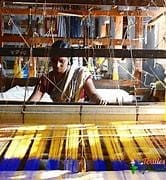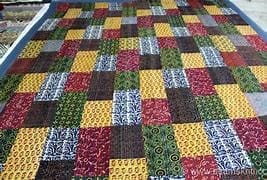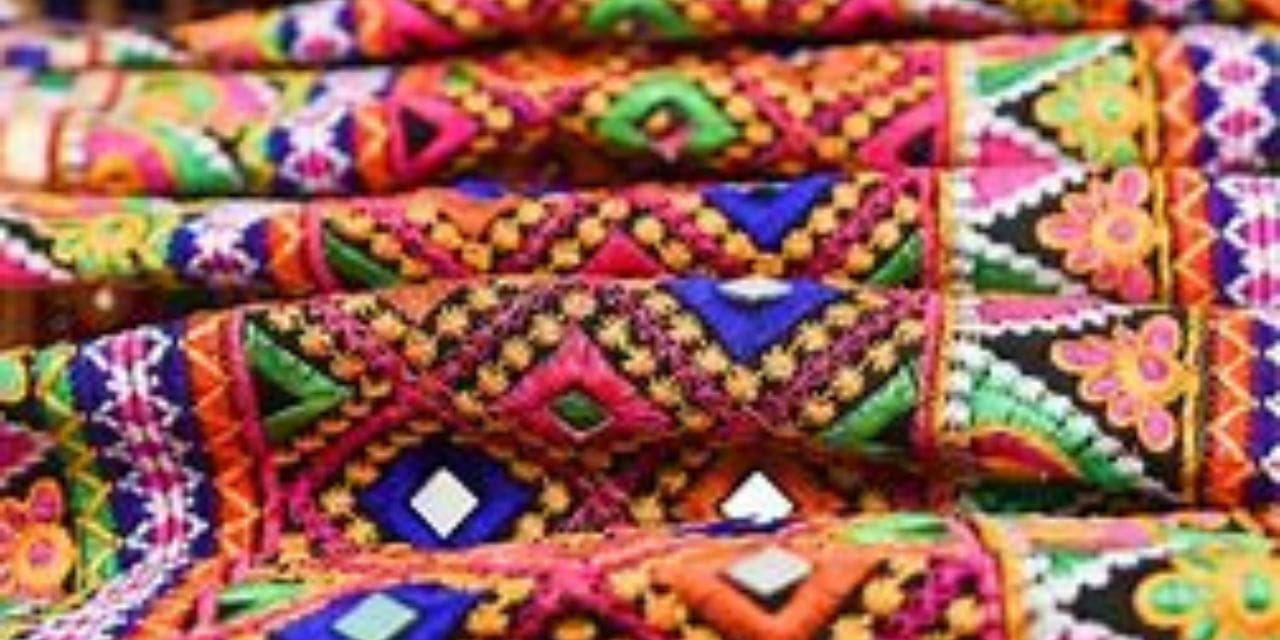

Neetu Saini1 Radha Kashyap2
1Research Scholar, Department of 2Head and Professor, Department of
Fashion and Textiles, IIS (Deemed to be University), Fashion and Textiles, IIS (Deemed to be University),
Jaipur, Rajasthan, India Jaipur, Rajasthan, India
Abstract
Traditional handicraft artifacts express the artist’s emotional connection to art and craft. The Barmer traditional handicraft-making process emerged slowly through the disciplined efforts of several generations, retaining its seasoned religious and cultural values, as well as the freshness and charm of its own beauty and utility, combined. Traditional handicrafts are a vibrant testament to the vital life force of the people. With visual manifestations of Barmer craft and culture, the craft of Barmer has increased its skills in traditional handicraft work. This research paper investigated the socioeconomic conditions of Barmer artisans, particularly the applique women artisans of the Mewar community of Dhanu village, who have their own cultural values that guide their socioeconomic life. Cultural factors can help us understand the economic system of applique artisans.
Key words: Applique, Pipili, Handicraft, Socio economic
Introduction
Traditional arts and crafts have contributed to the advancement of Barmer culture. Using religious and folk symbols and norms in traditional handicraft work is an effective method in Barmer. Barmer has a rich cultural heritage of handcrafted products. Cane work, art textiles, Pattu, applique work, and other popular crafts include silver filigree, brass and bell metal, and cane work. In Barmer, most applique work has been done traditionally for a long time in the Dhanu village applique, which is considered to be the center of the applique craft. Traditional applique craft production in Barmer is more or less associated with socio-cultural and religious functions.

The applique craft of Barmer artisans is producing different domestic decorative items made out of cloth decorated with colorful applique work. Traditional applique crafts these days can be seen on utilitarian items such as bags, camel covers, blankets, etc. Applique embroidery can also be seen on blouses, cushion covers, gowns, and other garments such as sarees, curtains, etc. In Barmer, there is a tradition of stitching large applique canopies with a range of panels of squares in different color combinations used in festivals. Applique work provides several employment opportunities in the handicraft sector. An applique artisan is a worker who sells his labor and skills to earn wages either on a daily, monthly, or piece rate basis. He does not invest any capital, but may use his own tools, which do not have much monetary value. He bears no risk. The artisans, most of the time, fulfill the demands of the traders. They prepare applique products according to the orders of the traders. It is a traditional craft in which all the members of the family are more or less involved. The decision to produce applique craft is made by either the family head or a member who is skilled at preparing applique craft. The evolution of the development of applique crafts regarding the creation of different motifs or designs, techniques for patchwork, manual and machine stitching, mirror work, etc., that has started in the last two decades is remarkable. This is possible due to the presence of master trainers, skilled and excellent traders, manufacturers and craftsmen, and the entrepreneurship of master craftsmen and manufacturers.
This work demands a high degree of risk, more tension, and physical labour. It is also caused by social stigma and gender bias. Because of the patience, intricacy, and concentration required to complete finer artistic works, women account for 70% of artisans. As more ladies work as artisans in their homes, it has been discovered that their children have learned the skill and assisted them. The craftsman is innovative and can create a new product based on consumer demand. Wall hangings, bags, and purses are important product mixes of non-traditional applique products. The development of new products, as well as the ornamentation of existing products, can lead to a more profitable market. Applique is a traditional and family-oriented Barmer craft. With time and experience, the family members developed into skilled and excellent craftsmen, manufacturers, and traders. They manufactured a variety of traditional as well as non-traditional products.
To raise marketability, appliqué manufacturing requires appropriate quality control, advanced artistic work, versatile and developed designs, the introduction of new products, and proper advertisement. At the moment, appliqué is regarded as one of the most promising and diverse crafts. Traditional product production and its implications for modern design meet the demand patterns of domestic and international buyers. Customers stated that the large number of consumers for utility items and non-traditional applique items is the reason for the increase in demand. In terms of customer behaviour, it has been observed that applique items are mostly purchased for personal use or for seasonal festivals.
The applique artisans of the Barmer region have limited earning potential and prevent unnecessary ostentation. Even in the materialistic age of contemporary socio-cultural life, the village’s generally accepted ideal is a simple life and high thinking. Every individual artisan strives to achieve and uphold the ideals of his family and caste in social and cultural life. The applique artisans are capable of feigning cultured behavior as well as boasting. They have empathy for others and want to meet on a natural and human level. Their way of life is tranquil, peaceful, and simple, with few mental conflicts or complexities. Everything within their lives follows a predetermined pattern, resulting in a division of labor among them. These artisan people keep thinking about these things. The small necessities of life are met by the applique artisans themselves.
In terms of religion, the population of applique artisans compares favorably with the population of urban life, being more inclined in this direction. This disparity is caused by a number of factors, the most prominent of which is their preoccupation with handicrafts, which are heavily reliant on tourism. The lives of applique artisans in rural areas are almost entirely dependent on the whims of nature. The folk religion of applique artisans is based on nature worship, which is prevalent in all aspects of applique artisans’ socio-cultural lives. Attached to the socio-cultural life of applique artisans.

The socio-cultural life of applique artisans attaches all kinds of superstitions to natural phenomena. Many moral beliefs are conjoined to the applique artisans’ religious life. A benevolent person of high character who worships God with fervor is commonly recognized as a religious person or superior soul. In spite of a lack of agreement, artisans generally look upon acts of kindness and assistance, both moral and concrete, to the poor and the helpless, as benevolent. As a matter of fact, applique artisans belonging to different religions are found co-existing in daily life. Religiousness is a fundamental element of an artisan’s socio-cultural life, for which applique artisans still cling to tradition and are no less religious than their ancestors, despite various changes that may have intruded into their religious notions and beliefs.
Whatever their economic status, literacy rate, or rate of progress, most applique artisans’ communities have their own socio-cultural way of life that includes traditional practices, art and crafts, rituals, legends, and ballads, among other things. The socio-cultural life of applique artisans incorporates new influences while maintaining tradition and continuity. Despite their preoccupation with the constant battle for survival, the applique artisans have preserved a rich and diverse heritage of socio-cultural practice and socio-economic life. The economics, which are an integral part of their festivals and rituals. The artisan community has its own set of cultural values that govern their cultural system of applique artisans can be understood through the lens of cultural factors. Non-economic factors such as social and cultural relationships may be considered non-essential in conventional economics. But they are the artisan’s reality for the very organization of their economic process.
The applique artisans are being transformed in accordance with the increase in urbanization. Furthermore, improved communication facilities increase the mobility of applique artisans, and the artisan population is adopting the habit of traveling to different cities for business and other employment opportunities, which has an impact on traditional life.
References
Bhandari, V., Rani, A., & Sakshi (2019). Aipan an inspiring folkart for textile designing. International journal of current microbiology and applied sciences., 8(6), 527-537. Retrieved from: https://www.ijcmas.com/8-6-2019/Vandana%20Bhandari,%20et%20al.pdf
Calibri, II. (2014).Valorization of cutting steps wastes creation of patch work fabrics and design of patch work. International conference of Applied Research on Textiles, CITRAT-6., 13 – 15. Retrieved from: https://www.researchgate.net
Dash, M., & Mishra, B. (2021). Problems of handicraft artisans: An overview. International Journal of Managerial Studies and Research (IJMSR), 9(5), 29-38. Retrieved from: https://doi.org/10.20431/2349-0349.0905004.
Mishra, R. and Pant, S. (2015). A Study of Changing Trends in Kashmiri Shawls With Special Reference To Designs And Designing Technique (Banasthali Institute of Designing, Tonk, Rajasthan). Retrieved from shodhganga.inflibnet.ac.in/handle/10603/139707
Mohapatra, S. (2011). Problems Associated with Artisans in Making of Handicrafts in Orissa, India. International journal of Managerial Studies and Research (UMSR), Vol(6), pp29-38. Retrieved from https://doi.org/10.20431/2349-0349.0905004 www.arcjournals.org
Mohanty, B. (1980). Applique craft of Orissa. Calcio Museum of Textile , Ahmedabad: General editiors Alfred,Buhler, 5(1), 29-32. Retrieved from https://www.gujarattourism.com/central-zone/ahmedabad/calico-museum-of-textiles.html
Srivastav, M. (2014). Efficiency of developed gender specific training module on care of clothing and renovation. Asian journal of Home Science, 9(3), 48-53. Retrieved from www.isca.in/IJSS/Archive/v4/i3/8.ISCA-IRJSS-2014-310.pdf
Yaqoob et al (2012). Pashmina Shawl- A Traditional Way of Making in Kashmir. Indian Journal of Traditional Knowledge, 11(2), 329-333. Retrieved from re.indiaenvironmentportal.org.in/files/file/pashmina%20shawl.pdf

